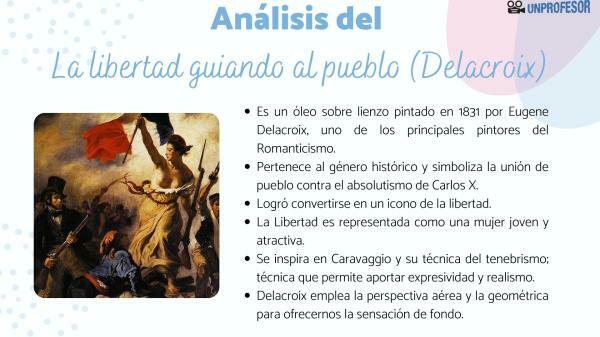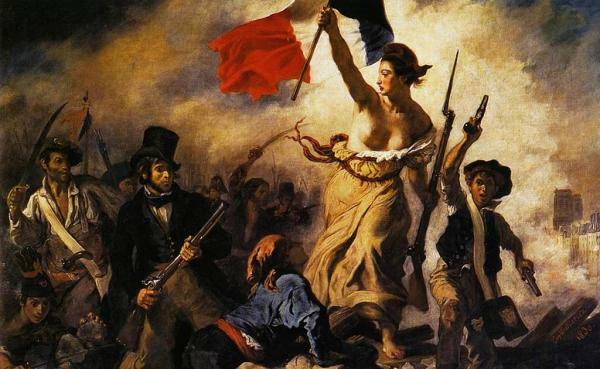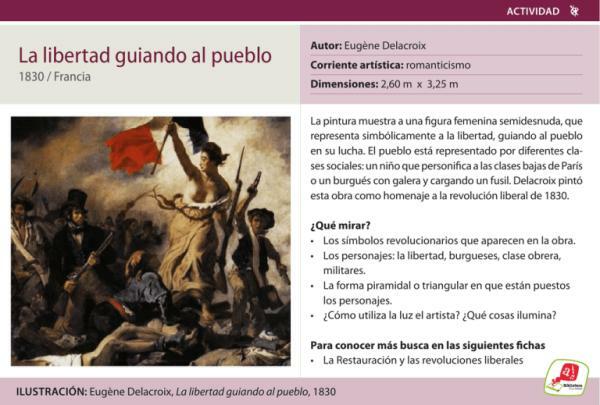Liberty Leading the People of DELACROIX: Commentary and Analysis

Eugene Delacroix (1798–1863) is considered as the great French romantic painter. A benchmark for his generation and generations of future artists for his bold style to the painter, in addition to his masterful use of color. Although trained in neoclassicism, Delacroix soon found himself attracted by the work of classical artists like Velázquez, Rubens, Rembrandt or Goya, in addition to being inspired by medieval ruins and constructions.
Some influences to which he added his taste for travel and the learning that he acquired in each of them. The influences of the English landscaper Constable or that of light and the exoticism of North Africa are other keys to Delacroix's style and that we can appreciate in works such as Liberty Leading the People.
In this lesson from a TEACHER we offer you the comment and analysis of Freedom guiding the people by Delacroix.
Index
- Commentary on Liberty Leading the People by Delacroix and Historical Context
- Analysis of Liberty Leading the People
- Style and era of Liberty Leading the People
Commentary on La Libertad guiding the town of Delacroix and historical context.
Freedom guiding the people or The 28th of July is an oil on canvas painted in 1831 by Eugene Delacroix, one of the leading Romanticism painters. A work that has dimensions of 260x325 centimeters and is currently located in the Louvre Museum.
This painting belongs to historical genre and symbolizes the union of the people against the absolutism of Carlos X. It is an allegorical painting about the July Revolution of 1830, which took place in Paris and in which the arbitrariness and injustices committed by Carlos X during the Second Restoration.
This painting is a symbolic representation of a historical reality and managed to become a freedom icon above specific moment that is represented.
Liberty is represented by Delacroix as an attractive young woman that flies the flag of France as a symbol of the freedom that is desired for the French people. Delacroix also reflects in the work all social classes, from the bourgeoisie to the patriotic youth or the fallen soldiers who have not obeyed the order to shoot at the people.

Analysis of Freedom guiding the people.
Freedom guiding the people presents a pyramidal composition with the following structure:
- She has one of the vertices of her in the arm of Liberty, a young woman, in addition, wears other symbols of the revolution such as the tricolor flag or the Phrygian cap.
- The other side is marked by the figure of a dying man whose clothes have the same colors as the flag.
- The base of the pyramid is formed by the dead and the remains of the barricade, recalling this scene from the base to the painting of The raft of the Medusa of Gericault.
To this close-up are added other plans: a second plane in which the representatives of the people appear as the bourgeois (it is considered that it may be a self-portrait de Delacroix), the boy armed with a pistol, the people fighting in a third plane and closing the plane the tower of Notre Give to me.
Regarding the colorDelacroix opts for a very loose brushstroke, contrasting blue and red with ocher and gray, with color predominating over the line. Delacroix shows us his facet of great colorist and the influence of Venetian painters, Rubens and Goya.
The light comes from the left side of him illuminating the dead and dying in the foreground, Liberty and the characters that symbolize the unity of the people. A relevant aspect in romantic painting, inspired by Caravaggio and his technique of tenebrism; this technique that allows to contribute expressiveness and realism through chiaroscuro.
Delacroix employs the aerial and geometric perspective to offer us the sensation of the background, in addition to using various foreshortenings to give the sensation of depth.

Image: Studylib
Style and time of Freedom guiding the people.
The Romanticism it develops between the Restoration of 1815 and 1848. A time of liberal revolutions and nationalist movements, in addition to being the starting point of the Industrial Revolution.
Thus, Romanticism constitutes a cultural and ideological movement in which freedom, individualism, intense and exalted feelings are exalted, in addition to valuing the historical past, traditions, in addition to everything exotic.
In art the taste for nature prevails, especially among English and German landscape painters, in addition to preferring color over drawing and compositions full of movement and dynamism.
Freedom guiding the people Delacroix is a clear example of Romanticism by representing one of the typical themes of romanticism, the love of freedom.

If you want to read more articles similar to Liberty Leading the People - Commentary and Analysis, we recommend that you enter our category of History.
Bibliography
- ALBERTI, Rafael; STANDISH, Peter. Delacroix (1798-1863). Online and color. Vervuert Verlagsgesellschaft, 1999. p. 149-150.
- ALLARD, Sébastien. Delacroix and the idea of the subject in painting. In Delacroix: from idea to expression (1978-1863). El Viso, 2011. p. 24-59.
- DELACROIX, Eugene. Liberty Leading the People, 1830. Oil on canvas, vol. 260, p. 325.
- BAUDEARIE, Ch, Delacroix, Casimiro Libros, 2011
- METKEN, G. Life of a painter. Biography in testimonies and documents in Eugène Delacroix. Prado Museum. Villahermosa Palace. March 2-April 20, 1988. 1988.
- MORENO, Clara Aragón. Liberty Leading the People – Eugène Delacroix.
- NAVARRO, Carlos G. Eugène Delacroix and the lineage of modern painting. Discovering art, 2016, no 207, p. 65-70.
- PEYRO, Ignacio. Delacroix, Anatomy of Genius. Epoca, 2011, no 1368, p. 36-40.
- SAVED, Neus. Delacroix: standard-bearer of French romanticism. Clío: History Magazine, 2012, no 127, p. 44-53.
- UBERQUOI, Marie-Claire. Delacroix: the search for the sublime. Discover art, 2011, no 153, p. 30-38.
- VVAA, Delacroix: From idea to expression (1798-1863), El Viso, 2011


